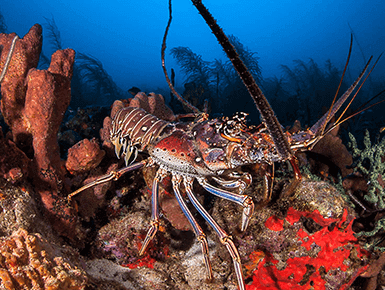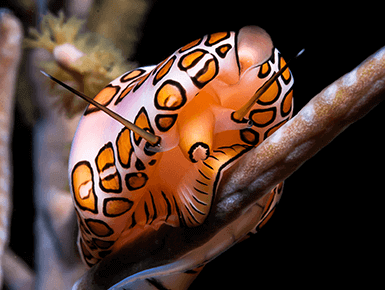
The Caribbean's New Frontier
For decades, Cuba remained off-limits to American divers. Now the reefs are ripe for exploration. With more than 3,500 miles of coastline, the largest island in the Caribbean offers an enticing sea of possibilities. Most exciting for North American divers are the walls and reefs of the Zapata region, and the offshore archipelago known as Jardines de la Rena, the Garden of the Queen. Lying 60 miles south of the main island, and enjoying strict protection for more than two decades, this archipelago of coral reefs, small islands and mangrove forests is considered one of the Caribbean's last pristine marine environments. Here, extensive coral formations riddled with canyons and tunnels shelter snappers and large grouper, and underwater walls plummet into the depths. Silky sharks, schooling tarpon and Caribbean reef sharks patrol walls and slopes, while stingrays and eagle rays glide across sandy plains. Divers also have a rare opportunity to snorkel with American crocodiles.
Highlights
- Best for: Liveaboard Diving
- Best season to visit: Year-round
- Weather: Mid 70s in winter to high 80s in summer. The rainy season runs from May to October, but precipitation does not affect diving conditions
Things to Do
- Before and after dive trips, travelers can explore historic Old Havana on People to People stays to immerse in the island's rich
Cuba Information
About Diving in Cuba
Dive tourism infrastructure in many areas of Cuba is a work in progress, with most shops operating as joint ventures with the Cuban government. The favorite destinations for North American divers are along the south-central coast and the outlying islands of the Gardens of the Queen. Most sites are protected from ocean swells, with water temperatures that dip into the high 70s in winter and rise to the mid-80s in summer.
Diving in Cuba Tips
If you are diving in the Zapata region, you can make day trips from land-based resorts, but the best sites are reached by liveaboards. The only way to gain access to the Gardens of the Queen is by liveaboard. Because the government imposes strict limits on the number of divers allowed in this reserve, it's a good idea to book early to guarantee a spot.
Best Places to Dive in Cuba
The 1.5 million-acre Zapata Biosphere Reserve encompasses marshes, mangroves, and coral reefs. A signature feature of many dive sites are caverns and vertical walls covered with sponges and black coral. Off Cuba's southern coast, the Gardens of the Queen is the largest marine reserve in the Caribbean. Thanks to strict protections, this expanse of more than 250 small islands contains some of the western hemisphere's most pristine reefs. Marine life is equally impressive, including large Goliath grouper and silky, Caribbean reef, blacktip, lemon, hammerhead, and nurse sharks, plus the occasional whale shark.
What to Pack for Diving in Cuba
Pack gear and personal items in soft-sided luggage or duffel bags when making liveaboard trips, as these will be easier to stow in onboard lockers once you are aboard. Tropical-weight clothing is appropriate most of the year, but a light windbreaker is in order for winter trips when sea breezes can bring a slight chill to evenings on the deck.
Diving in Cuba
The largest island in the Caribbean is a relative newcomer to the recreational diving scene. In the 1990s, the Cuban government began a series of joint ventures with private partners to promote scuba in a number of the country's more popular resort areas. On the Atlantic coast, dive operations sprang up in Varadero, Cayo Largo and Cayo Coco. Portions of this coastline are lined by spur-and-groove barrier reefs that begin relatively close to shore. In other areas, large expanses of shallow water spread outward to encompass mangrove forests, grass beds and isolated coral reefs before transitioning to deeper water. Diver operators in these areas cater primarily to visitors looking to include a limited number of dives as part of a beach vacation. At Cuba's western tip, the area known as Maria la Gorda has emerged as one of the island's premier dive destinations. Wrapping around a sheltered bay are more than 50 dive sites that include dramatic underwater walls that have been compared favorably to those of the Cayman Islands. As part of the Cuban government's focus on tourism development, legislators have created marine protected areas that cover some of the country's best underwater landscapes. Several of these are located on the island's south-central coast, where reefs are washed in clear Caribbean waters. A resort was built on the Isle of Youth, giving divers’ land-based access to the protected reefs of Punta Frances National Marine Park. Some 80 miles to the east, several dive operations were established in the town of Playa Giron. These provide access to sites within the Bay of Pigs and the Zapata National Park. This coastline offers a mixture of shallow reefs, coral grottoes and walls, and fish life is abundant, thanks to protective status. Stretching between Playa Giron and the Isle of youth is a 75-mile archipelago of 250 small coral and mangrove islands known as the Jardines de la Reina or 'Gardens of the Queen.' This entire area was declared a National Park in 1996 and is recognized as one of the healthiest marine ecosystems in the Caribbean. There are no dive resorts or hotels in the park, and access is by permit only. A select number of liveaboard dive boats are allowed to bring divers into the reserve. The Jardines de la Reina offers near-pristine coral reefs and dramatic walls, with large populations of fish that includes schooling snappers, eagle rays, turtles and one of the last remaining populations of Goliath groupers in the Caribbean. These waters are also known for robust shark populations.
Passport and/or Visa Requirements
Entry/Exit requirements: A valid passport is required for all foreign nationals intending to visit Cuba. The passport must be valid for at least one month beyond the date of your expected departure from Cuba. Foreign nationals must also carry a tourist card (or visa), or a business or student visa.
Immunizations
Vaccinations are not required for entry into Cuba. Check with your doctor and the Centers for Disease Control on recommended vaccinations for travel at Health Information for Travelers to Cuba.
Culture and Customs
Modern Cuban culture is a rich blend of European and African influences shaped by centuries of Colonialism, capitalism and more seven decades of Communist governance. Once the favorite Caribbean playground of vacationing North Americans, Cuba and the United States severed ties when Fidel Castro came to power in the early 1960s. In the decades since, US Citizens were not able to travel legally to Cuba due to sanctions imposed by the Treasury Department. Recent changes to these sanctions allow for certain types of travel that include educational or cultural exchange elements. This includes divers, who can combine time on the reefs with marine biology talks and cultural visits to Havana and other destinations within Cuba to satisfy the requirements of the travel exceptions. The capital city of Havana is known for historic structures and its vibrant musical traditions. Tours into the countryside will reveal a different side of the country, as much of Cuba remains agricultural. A popular excursion is to the Pinar del Rio region, which is world-famous for tobacco cultivation.
Electricity, Phone and Internet Access
Although the power supply in Cuba is mainly 110 volts, most of the modern hotels have dual voltage with all the sockets in the room being 220 volts. Usually, in the bathroom, there is a 110-volt socket suitable for shavers and charging batteries.
There is virtually no broadband internet access in Cuba. Cuba's mobile network is limited in its coverage and uses “second generation” technology, suited to voice conversations and text messaging, but not Internet applications.
Travelers are encouraged to check with their carrier to see if their phone has international capabilities and to enable international roaming. iPhones do work in Cuba.
Water Quality
While water is filtered it is recommended to purchase bottled water to drink.
Language & Currency
The official language in Cuba is Spanish (Castilian), please understand that Cuban-Spanish contains considerable variation, and even native-Spanish speakers might be lost in translation at times. The majority of Cubans only know Spanish, but in larger cities and tourist areas, English is more commonly spoken.
Cuba has two currencies: you’ll hear these referred to as the local currency, or Cuban Peso, and the Cuban Convertible Currency, or Cuban currency for tourists. The two-currency system began in 1994, as a way for the government to deal with a weak economy. The Cuban Convertible Currency, or CUC, was initially created to be used in the tourism industry and for luxury goods. Today, it is solely used by tourists, at an exchange rate of $1USD = 1 CUC. One CUC is also the equivalent of 25 Cuban Pesos for locals. If you show up with the American dollar, you may not be able to exchange to the CUC or be charged an extra 10% commission on your charge. Oftentimes, Cubans are charged extra to deal with the American dollar, due to the U.S.-Cuba relationship and embargo.
Time
Cuba is in the Eastern Time Zone. Cuba does observe Daylight Savings Time. They are 5 hours behind Greenwich Mean Time (-5 during Eastern Standard Time) and 4 hours behind Greenwich Mean Time during Daylight Savings Time (-4 Eastern Daylight Time).
Location, Size and Population
Cuba is a Caribbean island nation under communist rule. It has sugar-white beaches and is dotted with tobacco fields, which play a part in the production of the country's legendary cigars. The capital, Havana, is lined with pastel houses, 1950s-era cars and Spanish-colonial architecture in the 16th-century core, Old Havana. Salsa music plays in the dance clubs and cabaret shows are performed at the famed Tropicana.
The main island (Cuba) makes up most of the land area 104,556 km2 (40,369 sq mi). The island is 1,250 km (780 mi) long and 191 km (119 mi) across its widest points and 31 km (19 mi) across its narrowest points.
Cuba has a population 11.48 million as of 2017.




